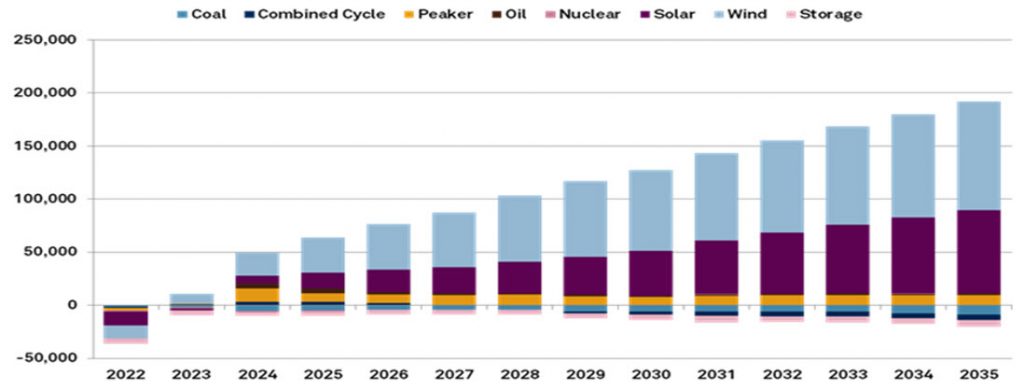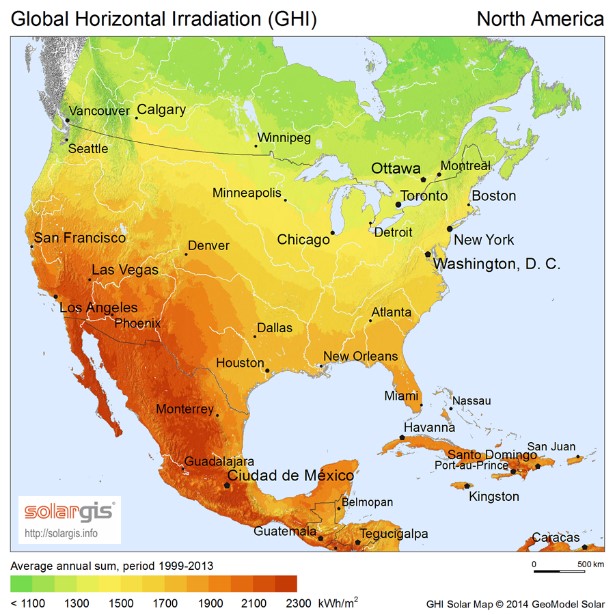Inexpensive electricity was a competitive advantage Ontario enjoyed for a long time. It started with the harnessing of the considerable hydro-electric potential; particularly the Niagara River with the Beck power plant that straddles Niagara-on-the-Lake and Niagara Falls. As demand exceeded the hydro-electric capacity, Ontario gradually shifted to a mix of hydro, nuclear and carbon that tried to keep costs low by matching the strengths of each type of generation with demand. In the early 2000’s coal was phased out and replaced by nuclear and gas.
The expert consensus is that we are now at the early stages of another major change in generation. The electrification of transportation and, potentially, heating and cooling will greatly increase the demand for electricity. Most of this new generation is expected to come from wind and solar. This can be seen in the forecast below for new generation in the USA as prepared by S&P Global Market Intelligence.

This is a problem for Ontario. Ontario will not be a low-cost producer of either solar or wind power. For obvious reasons, solar is cheaper the more sunshine there is in a year. As per the adjacent map, the closer to the equator you are and the drier the climate is the more sun you get. Ontario is neither of those. I expect the cost of solar power to continue to fall so that it becomes a valuable source of power even in Ontario. However, it will still be more expensive than in the Southwest US.

It is the same story with wind power. Ontario does have some decent locations along the eastern shores of the Great Lakes so wind will still be a source of power. However, the output of these will not compete on a cost basis with the foothills of the Rocky Mountains or some of the locations in Texas.

What can Ontario do to remain energy competitive? The following are some thoughts:
- Continue to look for opportunities in hydro-electric power. There is still unused potential in Ontario that has not been harnessed. The Government of Ontario has identified this as a source of power they want to continue to explore. What will be important is to avoid large overly costly projects like Muskrat Falls in Newfoundland and Labrador or Site C in British Columbia. Ontario also has significant technical expertise as well as a number of private sector companies able to invest in new hydro-electric power.
- Promote customer owned generation. If customers own some of the generation needed to supply their power that reduces the overall demand on the grid. This, in turn, means the lower cost hydro energy has a greater share of the total energy requirement and so drives down the cost. Making it easier for customers to have net metering contracts and allowing community solar are two potential steps to promote customer owned generation. The Government of Ontario has looked at community solar but hesitated due to current excess of supply. As we are expected to be needing more power in the near future now is the time to allow these investments.
- Continue to explore nuclear power. The S&P forecast for the US does include some nuclear power but it is overshadowed by wind and solar. The Government of Ontario, with three other provinces, is exploring Small Nuclear Reactors (SMRs) in the hope that these can eventually generate cheaper power and avoid the delays and cost overruns of the large nuclear stations.
- Continue to analyze time of use (TOU) rates. One of the most expensive challenges in generating electricity is matching the timing of the generation with demand. Even energy storage is no panacea for this as it is still very expensive. If demand can be shifted to match the timing of the generation, then that is a great way to lower costs. The electrification of transportation is a great opportunity to try achieve this as this demand should be much less time sensitive. The new TOU rates proposed by the Government of Ontario is the right first step in this direction.